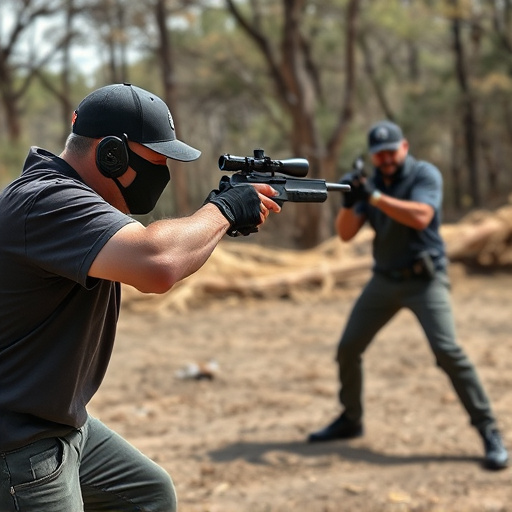Understanding crowd dynamics is key for effective riot control using Crowd Control Pepper Spray Techniques. Law enforcement strategize spray deployment based on crowd formation and communication patterns, prioritizing safety and efficiency. Oleoresin capsicum (OC), CN, and CS sprays disrupt crowds quickly, with OC being most common. Proper training in spray range, de-escalation, and usage is vital for successful integration with other crowd control measures, ensuring public safety during high-intensity riots.
In the realm of law enforcement, effective crowd control is paramount to maintaining public safety during high-tension situations. Among the tools employed, inflammatory spray, or pepper spray, stands out as a crucial game-changer. This article delves into the strategic deployment of crowd control pepper spray techniques, exploring key aspects such as understanding crowd dynamics, different spray types and their active ingredients, tactical application methods, and essential safety measures for law enforcement agencies.
- Understanding Crowd Dynamics for Effective Spray Deployment
- Types of Inflammatory Sprays and Their Active Ingredients
- Tactical Application Techniques for Optimal Control
- Safety Measures and Training Protocols for Law Enforcement Agencies
Understanding Crowd Dynamics for Effective Spray Deployment
Understanding crowd dynamics is a crucial aspect of effective riot control and the strategic deployment of inflammatory spray. In chaotic situations, understanding human behavior and crowd movement can help law enforcement officers make informed decisions about when and where to use pepper spray to disrupt and disperse crowds.
Crowd control pepper spray techniques require a deep knowledge of crowd formation, communication patterns, and potential leaders who may escalate or de-escalate tensions. By analyzing these dynamics, officers can anticipate crowd actions and respond accordingly, ensuring the safe and efficient control of riots. This involves observing crowd behavior, identifying key individuals, and using specific deployment strategies tailored to different scenarios, thereby enhancing the overall effectiveness of crowd control measures.
Types of Inflammatory Sprays and Their Active Ingredients
Inflammatory sprays, also known as pepper spray, are essential tools in crowd control techniques employed by law enforcement and security personnel during riots or high-risk situations. These specialized chemicals are designed to disrupt and disperse crowds quickly and safely. There are several types of inflammatory sprays available, each with unique active ingredients that contribute to their effectiveness.
The most common type is oleoresin capsicum (OC) spray, which uses a natural compound derived from chili peppers. OC spray causes irritation and temporary blindness by targeting the eyes and respiratory system. Other varieties include CN (chloroacetophenone) spray, known for its powerful irritant properties, and CS (cymru-3-carboxycyanide) spray, often used as an alternative due to its less intense but still effective effects. Each active ingredient plays a crucial role in achieving crowd control, offering tailored solutions depending on the specific challenges faced during riot situations.
Tactical Application Techniques for Optimal Control
In the heat of a riot, effective crowd control pepper spray techniques can be life-saving tools for law enforcement agencies. The tactical application of inflammatory sprays requires precise timing and strategy. Officers must assess the size and aggression of the crowd, ensuring the safe deployment of the spray to disrupt and disperse participants without causing excessive harm. Techniques include directed spraying at close range for individual disruption and wider, upward blasts to create a barrier between officers and rioters.
Optimal control involves understanding the spray’s range, effectiveness, and de-escalation capabilities. Training in proper usage, including safe distances and ventilation considerations, is crucial. Strategists emphasize the importance of combining pepper spray with other crowd control measures for comprehensive management. By mastering these techniques, law enforcement can efficiently navigate challenging situations while prioritizing both public safety and minimizing collateral damage.
Safety Measures and Training Protocols for Law Enforcement Agencies
Effective crowd control requires a comprehensive approach, and pepper spray is one tool that law enforcement agencies employ to manage and disperse large gatherings. However, the use of such irritants must be balanced with safety measures to protect both officers and civilians. Training protocols are essential to ensure that law enforcement personnel are equipped to handle these situations responsibly and minimize potential risks.
Agencies should provide extensive training on crowd control pepper spray techniques, covering proper application, range, and de-escalation strategies. Officers must learn to identify different crowd dynamics and adapt their responses accordingly. Regular simulations and scenario-based training allow law enforcement to prepare for various situations, ensuring they use the minimum force necessary while maintaining public safety during riot control operations.
Inflammatory spray, or crowd control pepper spray, is a powerful tool in law enforcement’s arsenal for managing chaotic situations. By understanding crowd dynamics, selecting the right type of spray with specific active ingredients, and employing tactical application techniques, officers can effectively de-escalate tensions and maintain public safety. Implementing robust safety measures and comprehensive training protocols is paramount to ensure responsible and effective use, minimizing harm and maximizing control during riotous events. Mastering these crowd control pepper spray techniques is crucial for modern law enforcement agencies navigating the complex landscape of public disorder.
